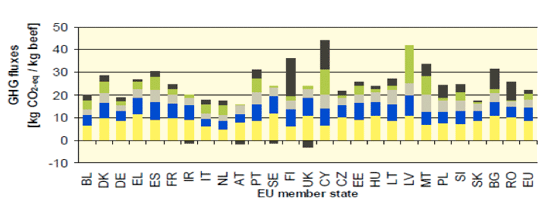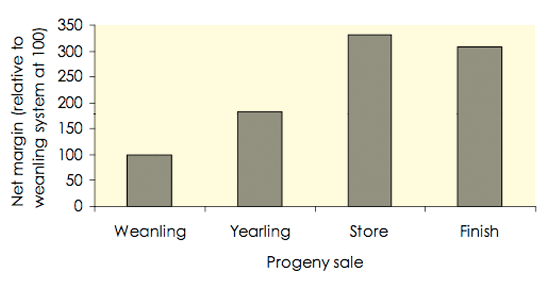



Suckler Beef Production In Ireland: Production Systems
Research by Paul Crosson and Mark McGee, at Teagasc Animal & Grassland Research and Innovation Centre focuses on profitability for suckler beef production. This section looks at the importance of production systems. Suckler beef production is the most widespread farm activity in Ireland. In 2009, there were 1.16 million suckler cows on 75,000 farms (CSO, 2011). Suckler farms have a wide geographic distribution in contrast to many other farming enterprises, which are concentrated in specific locations e.g. tillage farming in Leinster and dairy farming in Munster (CSO, 2007).
Thus, suckler farming makes an important contribution to economic activity in diverse regions throughout the country. The value of beef and cattle output in 2009 for the Republic of Ireland was €1.5 billion, representing 38 per cent of total agricultural output, and was the largest single agricultural sector (Department of Agriculture and Food, 2010). Approximately 50 per cent of total beef production, and a greater percentage of output value, derives from suckler beef production and therefore, this sector is a key income generator for the national economy.
Despite the importance of suckler beef farming to the national economy, profitability at farm level is extremely low, with average family farm income (FFI) in 2009 of €221/ha (Connolly et al, 2010). When direct payments, such as the Single Farm Payments and REPS payments, are excluded, the market-based FFI in 2009 was - €230/ha. It is apparent that suckler farming in Ireland is heavily dependent on direct payments to remain viable. Furthermore, suckler cow numbers are showing a downward trend (Figure 1; CSO, 2011), a worrying reduction in a key national asset.
Although low financial margins from beef farming are evident world-wide (Agri benchmark, 2006), there are a number of factors which favour Irish livestock production and these factors, if exploited, provide considerable opportunities to increase profitability on Irish suckler beef farms. The capacity to grow high yields of highly digestible grass at low cost (Finneran et al., 2011) is a key competitive advantage of Irish livestock systems particularly given current high concentrate feed prices. Irish suckler beef farms also operate at very low stocking rates (Connolly et al., 2010), thus higher output is readily achievable on many farms at modest cost.
The objective of this paper is to outline the key factors that contribute to farm profitability on Irish suckler beef farms. Clearly, the most important issue influencing farm profitability is input costs and the final product price; however, these aspects are largely outside of the control of individual farmers. Therefore, the focus of this paper is on the factors inside the farm gate influencing farm profitability for suckler beef farms.
Figure 1. Suckler cow numbers in Ireland 1999-2009 (Source: CSO, 2011)

Beef farming systems must be both profitable and sustainable in order to provide positive margin to labour and (non-land) assets employed in the longer term. In general, profitability must be maximised for the most limiting resource available on the farm. For individual farms, the most limiting factor may be facilities, cow numbers, and labour or land area.
Therefore, the respective profitability measures of most relevance in these individual circumstances are margin per livestock unit (LU), per cow calving, per unit labour employed or per hectare. Under Irish circumstances, land area is the most limiting factor since the remaining factors should not be long term limitations on profitability. Hence, the analysis conducted at Grange and reported in this paper is based on margin per hectare. Sustainability can refer to financial, labour and/or environment.
Of increasing interest, particularly to international markets, is the “carbon footprint” of agricultural products. This refers to the greenhouse gas emissions associated with the production and provision of goods or services. In this regard a recent EU study has shown that Ireland is very competitive with a carbon footprint of 18.4 kg CO2-eq/kg beef (carcass) as opposed to the EU average of 22.2 kg CO2eq/kg beef carcass (Figure 2).
Figure 2. The carbon footprint of beef for 26 European countries

The main focus of this paper is profitability. Research at Teagasc Grange has identified five key areas underpinning farm profitability for Irish suckler beef farms as follows:
- Production systems
- Stocking rates
- Calving date
- Grassland management
- Animal productivity
In the following sections, each of these areas will be discussed with respect to the impact on whole farm economic performance.
Production systems There are a myriad of production systems operated on suckler beef farms throughout Ireland, based on markets, tradition and demographics. Recent analysis at Teagasc Grange looked at the profitability per hectare of a range of suckler beef production systems where progeny were sold as weanlings, yearlings, stores (18 months of age) or as finished cattle (McGee et al., 2011). The results of this analysis are presented in Figure 3 with net margin for weanling systems set to a base of 100. It is apparent from these results that weanling systems returned substantially lower margins than any of the alternative systems.
The main reason for this is that the annual costs of keeping a suckler cow (approximately €400 in this analysis) are high and where this cost is allocated over a greater value of output, profitability is greater. Clearly, there are also opportunities for farmers targeting the live export market to attain substantially higher weanling prices and farm margins from weanling and yearling production systems. However, the proportion of suckler progeny exported live is small and thus, this is likely to remain a niche market. In general, where profit is the primary objective and production efficiency is maintained, this analysis indicates that production systems taking progeny to sale dates later than weaning, are more profitable.
Figure 3. Comparison of net margin from alternative suckler beef production systems

Further Reading
| - | You can view the full report by clicking here. |


